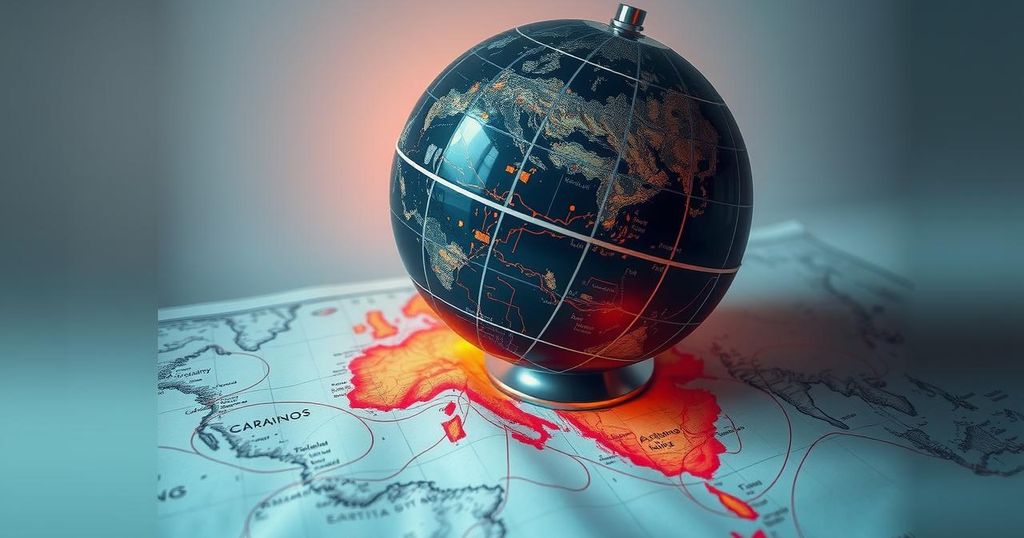The article details the eight most earthquake-prone countries: Greece, Japan, Indonesia, Turkey, China, Iran, Mexico, and the United States. It highlights the geological reasons for seismic risks in these nations, noting significant historical earthquakes and ongoing preparedness measures to protect their populations and infrastructure from potential disasters.
Greece has declared a state of emergency due to ongoing seismic activity in Santorini, which has reported thousands of tremors since late January. Among these, over 200 have been categorized as significant, raising alarms about the potential for severe earthquakes. Greece frequently endures earthquakes owing to its location on multiple fault lines, but it is not alone in this risk. Several other nations worldwide are similarly prone to substantial seismic events.
Japan is located at the intersection of four major tectonic plates: the Pacific, Philippine, Eurasian, and North American plates, rendering it one of the world’s most earthquake-affected countries. It records thousands of minor quakes annually, with catastrophic events such as the 2011 Tōhoku earthquake and tsunami occurring at intervals. Japan has established stringent building regulations and early warning systems to reduce earthquake-related damage.
Indonesia, situated along the Pacific Ring of Fire, is a significant center for tectonic and volcanic activity. The country regularly faces intense earthquakes often accompanied by tsunamis. The horrific 2004 Indian Ocean earthquake and tsunami, which started near Sumatra, ranks as one of history’s deadliest natural disasters, impacting millions across various nations.
Turkey is positioned above the North Anatolian Fault, one of the most critical earthquake zones worldwide. Major urban centers, including Istanbul, face dire threats from imminent earthquakes. The 1999 İzmit earthquake, which resulted in over 17,000 fatalities, underscores the essential need for advancements in infrastructure and emergency preparedness across the country.
Greece’s seismic activity is attributed to its location at the junction of the African and Eurasian tectonic plates. The islands of Santorini and Crete are especially susceptible to earthquakes. The recent uptick in seismic incidents around Santorini serves as a poignant reminder of Greece’s continuous earthquake vulnerabilities, which have historically influenced its terrain and architectural styles.
China has been afflicted by numerous powerful earthquakes, particularly in its western and southwestern regions. In 2008, the Sichuan earthquake, measuring 7.9 on the Richter scale, resulted in nearly 90,000 casualties. China’s susceptibility to seismic events stems from its placement on an array of fault lines, including the Himalayan seismic belt.
Iran stands out as one of the most seismically active nations globally. It resides at the convergence of the Arabian and Eurasian plates and has suffered a series of devastating earthquakes, one of which was the 2003 Bam earthquake that claimed over 26,000 lives. The fragility of construction in select areas exacerbates the impact of seismic episodes.
Mexico is located along the Pacific Ring of Fire, endowing it with a high likelihood of experiencing earthquakes. Historical tremors, such as the 1985 Mexico City earthquake, resulted in severe destruction and loss of life. In response to such disasters, Mexico has enhanced its earthquake preparedness through improved early warning systems.
The United States, particularly in California and Alaska, also experiences frequent seismic activity due to the San Andreas Fault and various tectonic borders. Notable destructive events include the 1906 San Francisco earthquake and the 1964 Great Alaska earthquake. While infrastructure has seen improvements over the years, these areas remain under significant risk from future seismic events.
The article discusses the eight countries most vulnerable to earthquakes due to their geographical locations on major fault lines. Each country experiences significant seismic activity, leading to devastating events in their histories. An understanding of the geological factors contributing to earthquakes in these regions can help in disaster preparedness and response efforts. It is essential to recognize the risks associated with living in earthquake-prone areas while exploring mitigation measures implemented by affected countries.
In summary, the reviewed countries—Greece, Japan, Indonesia, Turkey, China, Iran, Mexico, and the United States—demonstrate varying degrees of susceptibility to earthquakes due to their positions on significant tectonic boundaries. Historical earthquakes have revealed the necessity for rigorous preparedness and resilient infrastructure to safeguard populations and mitigate damage effectively. Continuous monitoring and improved readiness are vital for minimizing the consequences of future seismic activities.
Original Source: www.timesnownews.com






